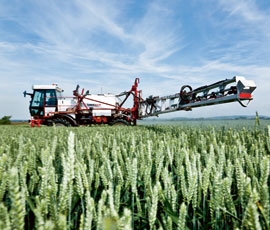Fungicide programmes in full swing

T3 fungicide applications were in full swing this week and our Crop Watch agronomists were starting to focus on cereal variety choices for autumn sowing.
“There is plenty of choice over selecting which wheat varieties to sow this autumn,” said Suffolk-based agronomist Marion Self, of Prime Agriculture.
“For all crops, disease resistance is important, although most weaknesses can be managed. For many growers, it is margin over fungicide costs that count.”
David Cairns, of McCreath Simpson and Prentice (Berwickshire), said Group 4 feed wheat varieties Viscount and Oakley may dominate plantings again in his area.
“Scout, with its good all-round disease resistance, looks promising in an early drill slot,” he added. “Santiago is also generating plenty of interest.”
For malting barleys, good contracts were available next season for Pearl and Cassata and Volume may also be popular, he noted.
Meanwhile, Mr Cairns said crops had greened up nicely over the past week after taking up some much needed nitrogen following the rain.
But he was concerned that winter barley may be starting to turn. “I’m just hoping that after the heavy rain and winds crops can remain standing until harvest,” he said.
Winter wheat will be getting a final T3 fungicide this week, based around prothioconazole and a strobilurin, because flag leaf sprays were hampered by wind and yellow rust was still showing in untreated pockets, he explained.
Neil Potts, of Matford Arable Systems (Devon), said wheat crops remained relatively disease-free with low pressure from septoria.
“Now we have had some rain, it may be wise to apply a T3 fungicide to prevent late ear diseases,” he added.
“If the crop still has reasonable yield potential this application should go ahead. It’s not worth risking the investment made in the crop for the sake of this final input.”
He has been recommending a dose of a fusarium active triazole, such as metconazole or prothioconazole, along with a low-rate strobilurin to maintain healthy green leaf area.
Mr Potts said winter barley looked “extremely promising” this year, having done most of its growing before the drought.
But spring barley was either “all or nothing”, he added. “Early-drilled crops planted into good seed-beds with plenty of fertiliser look outstanding. However, crops planted late into less fine or cloddy seed-beds look awful.”
AICC agronomist Tod Hunnisett, of Chichester Crop Consultancy, in Sussex, said that the recent rain had justified continuing with the T3 fungicide programme as many crops will continue to stay green for a near normal period of time.
“All my wheats are getting a triazole/strobilurin ear-wash, but the fungicide spend this year will be similar or less than last year,” he explained.
The rain had also helped final germination of all spring-drilled crops, he said. “Once the weather warms up, I’m sure the maize will take off nicely.”
However, as conditions were dry at drilling, hardly any crops received a pre-emergence herbicide and those that did nearly all needed over-spraying, Mr Hunnisett said.
“Broad-leaved weed control in linseed crops has been average,” he added. “But at least the crop price remains high.”

